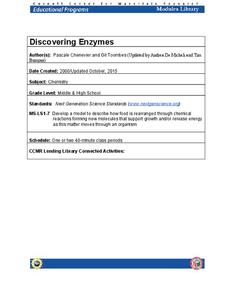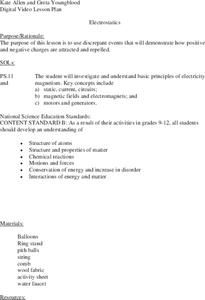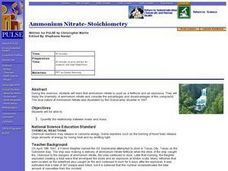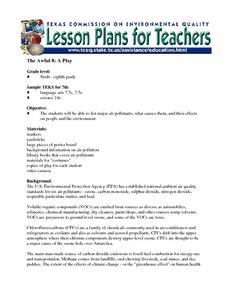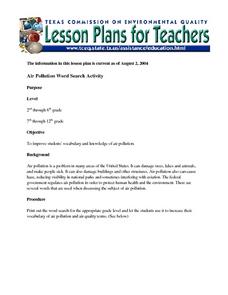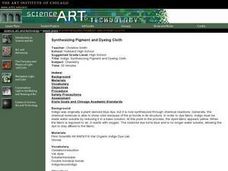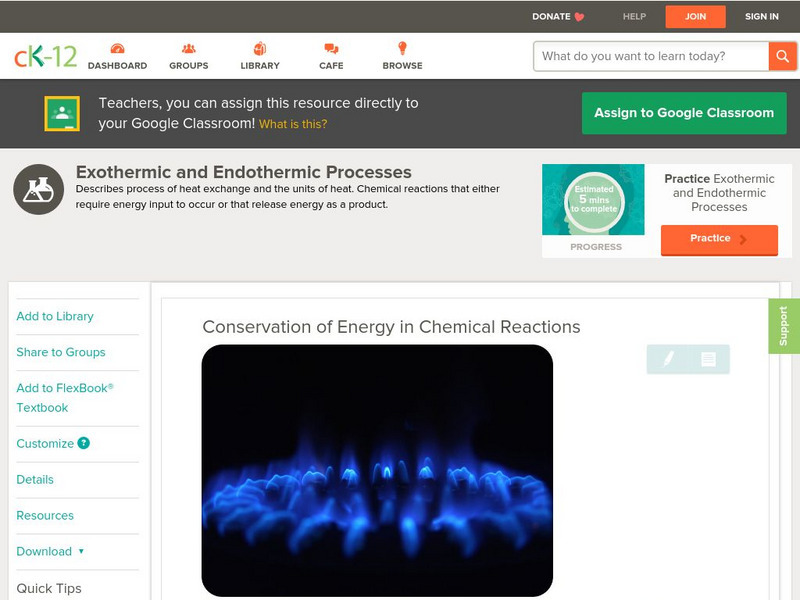Cornell University
Making a Battery
Don't be shocked when your class has a blast making their own batteries! Science scholars examine a dry cell battery, then design and construct a wet cell battery. The activity guides them through the parts of a battery, the variables...
Curated OER
Temperature
Several slides compare different temperature scales. Thermal expansion, heat transfer, and Maxwell speed distribution are also explored. The last two slides seem unrelated to the topic of heat, but are easily left out of this otherwise...
Cornell University
Discovering Enzymes
Explore the function of enzymes through a series of lab investigations. Learners use household enzymes such as hydrogen peroxide to model the role of enzymes. The enzymes break down proteins with and without a catalyst.
Curated OER
Tour of the Cell 1
Each of these slides deals with an individual organelle and displays a diagram along with labels of the structures. The most useful components of this slideshow are the summaries of functions and descriptions of how the organelles are...
Curated OER
Electrostatics
Students examine ways positive and negative charges are attracted and repelled by watching teacher demonstrations, and complete activity sheet related to classroom demonstration activities to prove proficiency of knowledge of...
Curated OER
WHAT MAKES A LIGHT BULB LIGHT?
Young scholars are able to use inquiry to answer the essential questions. They are able to predict and test configurations of a battery, bulb, and wire that make the complete circuit. Students craft a group and individual theory of a...
Curated OER
Enzymatic Action
Students observe how a cell uses an enzyme to rid itself of a poisonous substance by experimenting with hydrogen peroxide, potatoes, liver and carrots. They record the temperature and changes of the hydrogen peroxide as other elements...
Curated OER
Einstein's Big Idea
High schoolers investigate the concept of the Einstein's Theory of Relativity while conducting research using the internet and following the outline of the objectives to guide the information search. The lesson includes background...
Curated OER
Plant Pigments
Students investigate the components of chlorophyll. They use paper chromatography to separate the many pigments of chlorophyll from one another.
Curated OER
Unknown Element Project
Students work with a partner to determine the identity of an unknown element based on given descriptions. Groups use classroom textbooks, encyclopedias, and science internet sites to identify their unknown element then write a report as...
Curated OER
Ammonium Nitrate- Stoichiometry
High schoolers quantify the relationship between moles and mass. They comprehend that ammonium nitrate is used as a fertilizer and an explosive. Students study the chemistry of ammonium nitrate and consider the advantages and...
Curated OER
The Awful 8: A Play
Students perform a play that presents the causes and effects on people and the environment of the eight major air pollutants.
Curated OER
Air Pollution Word Search Activity
Students examine the issues surrounding air pollution. They discover how it affects peoples health and the government's regulations. They complete a word search activity to practice the vocabulary.
Curated OER
Using VNTR Analysis to Identify Guilt at a Crime Scene
High schoolers collect DNA from cheek cells. They compare and contrast the processes of DNA replication and PCR. They discuss how this information can be used to determine guilt at crime scenes.
Curated OER
Synthesizing Pigment and Dyeing Cloth
Students create a synthetic dye and oxidize the dye and record the effects.
Curated OER
Cytoplasmic Streaming
Students prepare successful wet mount slide of Elodea. They determine and identify environmental conditions that induce cytoplasmic streaming. They determine the positive aspects of cytoplasmic streaming. They illustrate knowledge and...
Concord Consortium
The Molecular Workbench Database: Energy Conservation in Chemical Reactions
Follow the energy conversion from potential to kinetic in this interactive activity that explores total energy in chemical reactions.
TED Talks
Ted: Ted Ed: Activation Energy Kickstarting Chemical Reactions
Chemical reactions are constantly happening in your body - even at this very moment. But what catalyzes these important reactions? Vance Kite explains how enzymes assist the process, while providing a light-hearted way to remember how...
CK-12 Foundation
Ck 12: Physical Science: Conservation of Energy in Chemical Reactions
[Free Registration/Login may be required to access all resource tools.] Covers the law of conservation of energy and how energy is conserved in chemical reactions.
CK-12 Foundation
Ck 12: Physical Science: Conservation of Energy in Chemical Reactions
[Free Registration/Login may be required to access all resource tools.] Describes the law of conservation of energy and how energy is conserved in chemical reactions.
OpenStax
Open Stax: Chemical Reactions
This site provides an overview of the role of energy in chemical reactions.
American Chemical Society
Middle School Chemistry: Energy Changes in Chemical Reactions
Learners will conduct two chemical reactions: endothermic and exothermic. They will see an animation that shows that it takes energy to break bonds and that energy is released when new bonds are formed, and use that animation to explain...
TED Talks
Ted: Ted Ed: How to Speed Up Chemical Reactions (And Get a Date)
This video explores by analogy what factors speed up reaction rates in chemical reactions. [4:56] Includes a brief quiz and a list of additional resources to explore.
BBC
Bbc: Gcse Bitesize: Heat Energy Changes in Chemical Reactions
This lesson focuses on heat energy changes in chemical reactions. Exothermic reactions transfer energy to the surroundings. Endothermic reactions take in energy from the surroundings. It also offers links to a video and a test.


